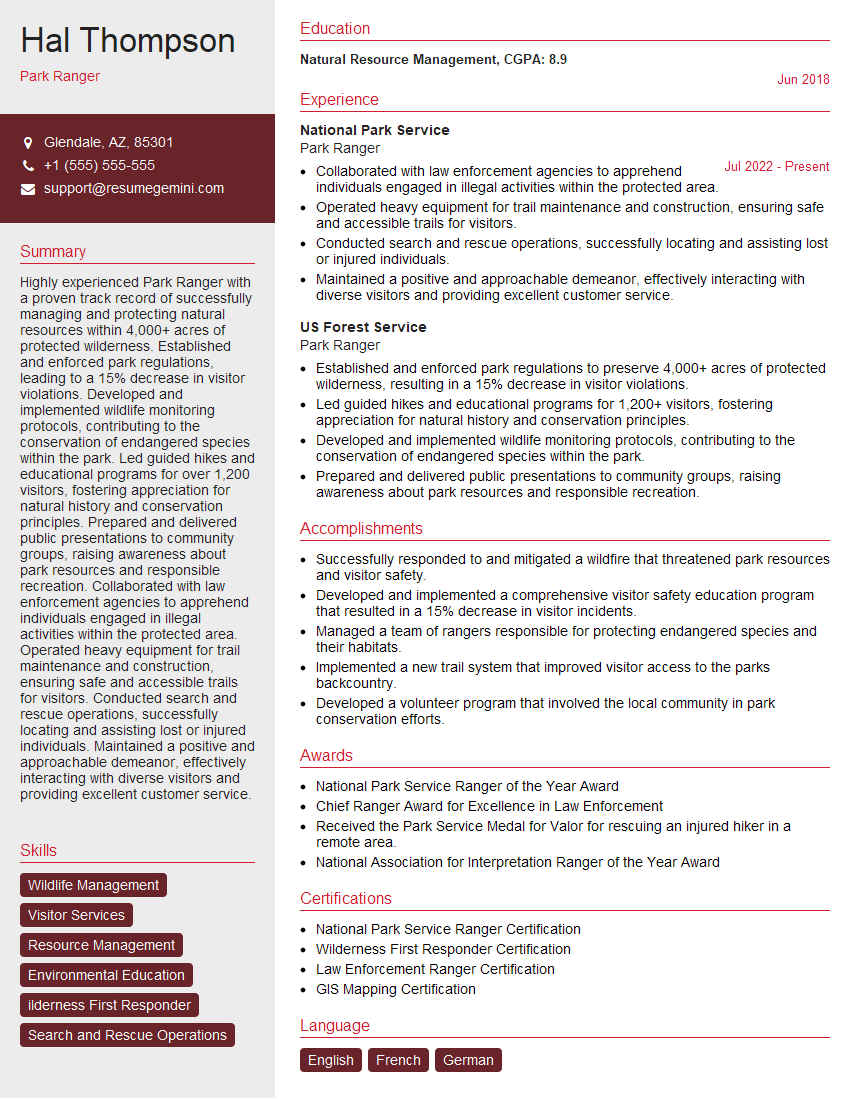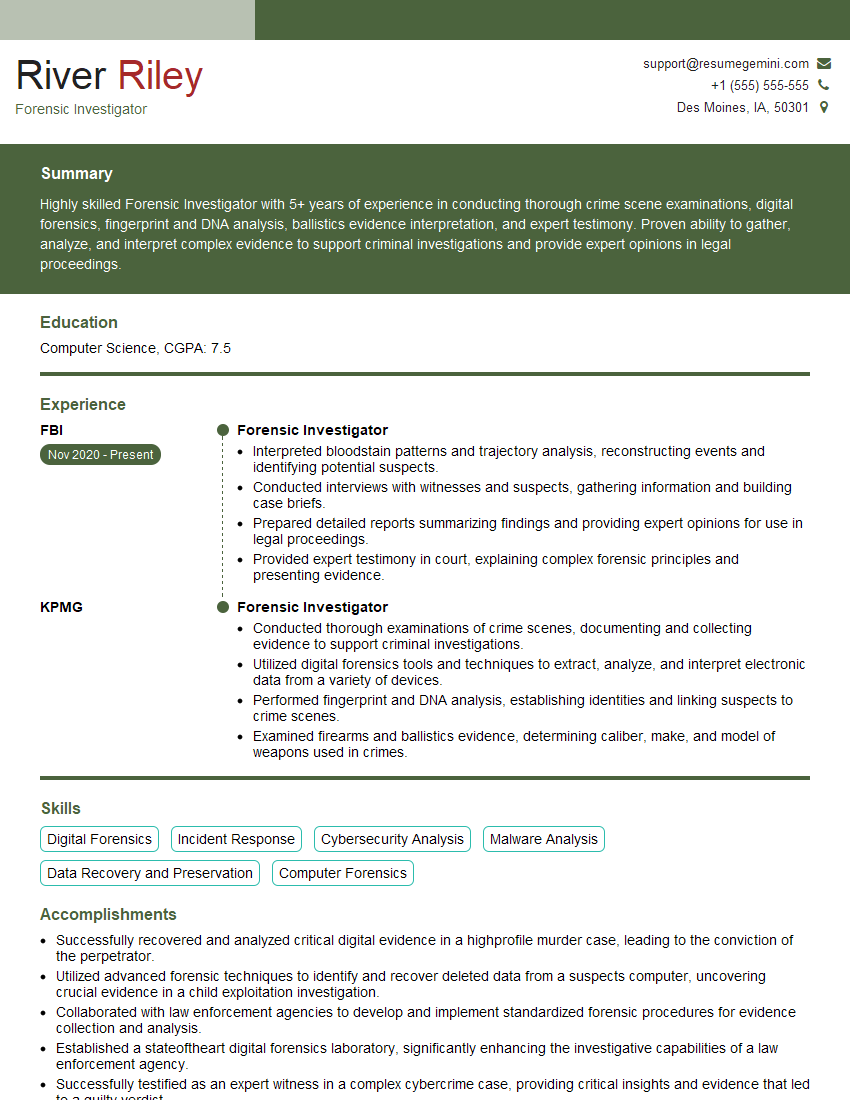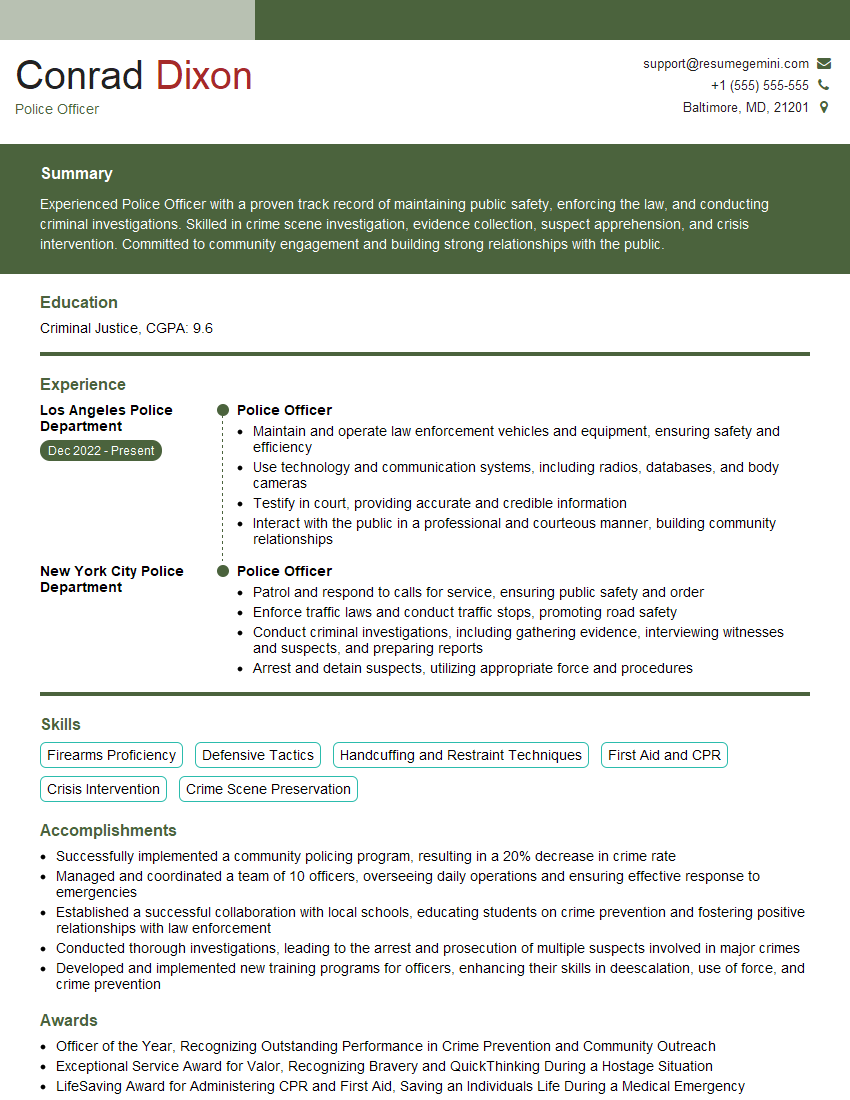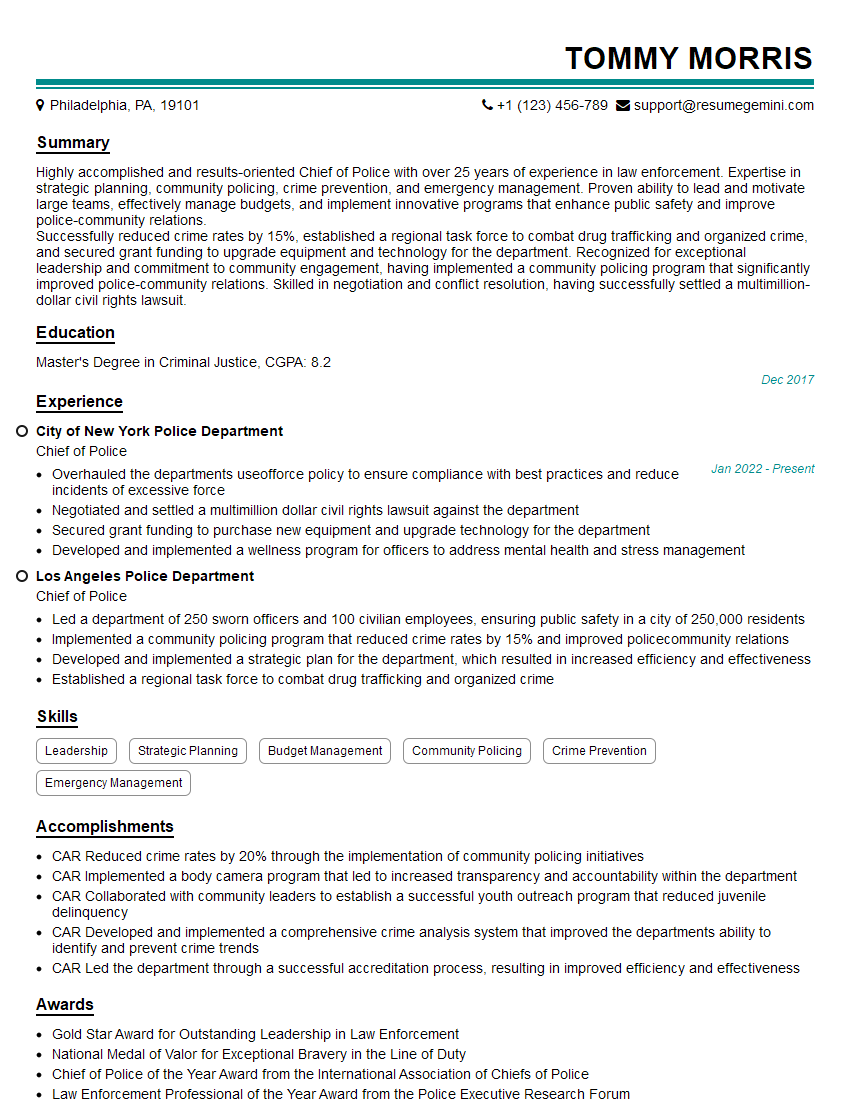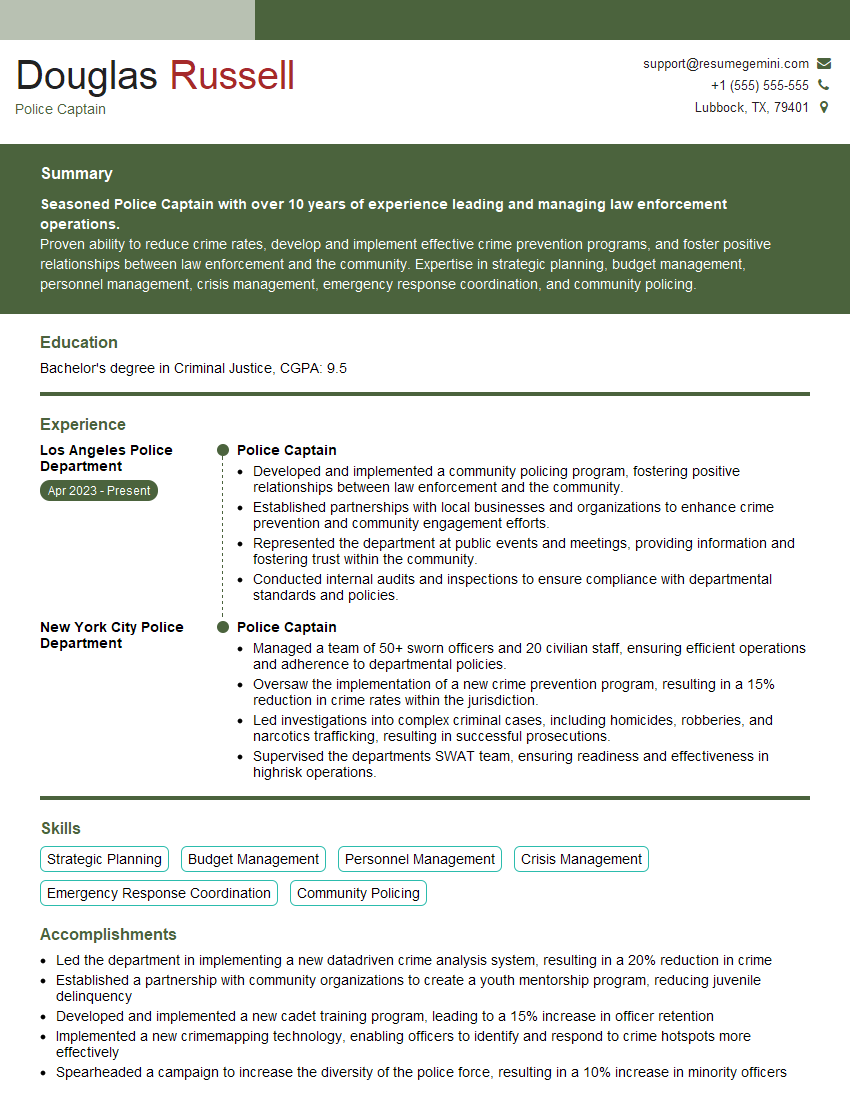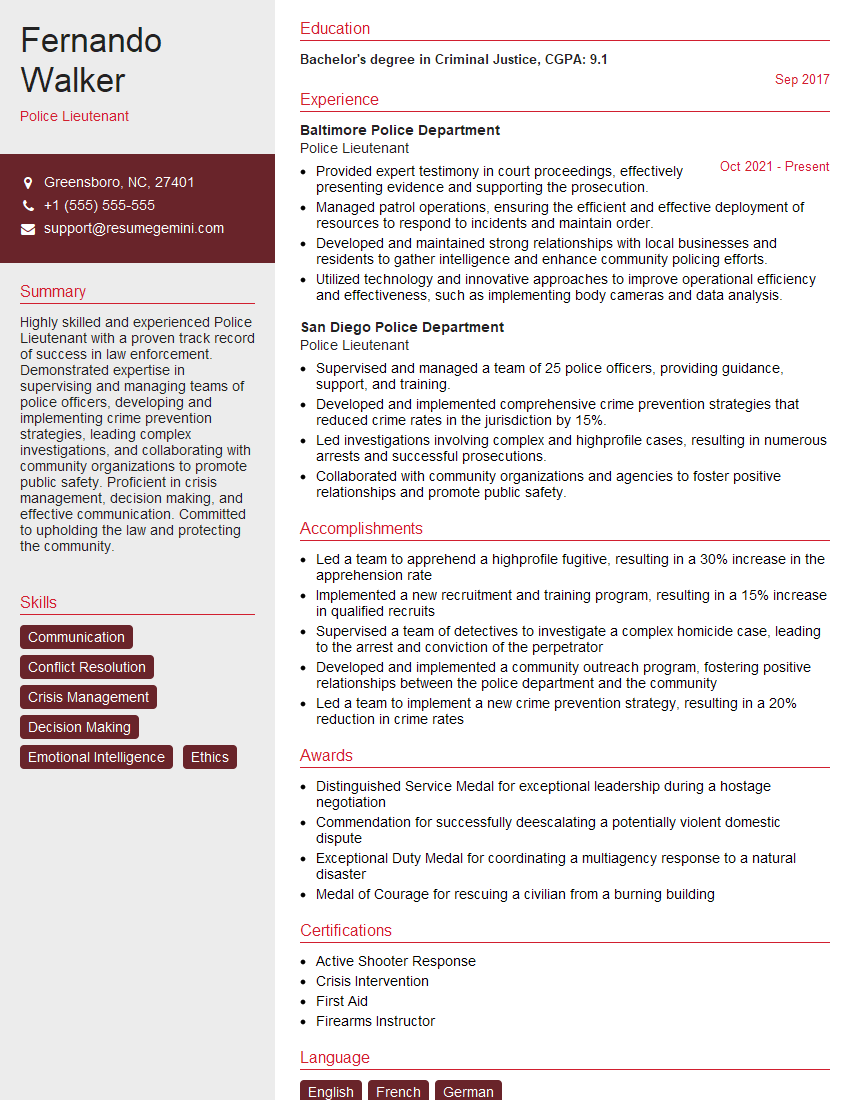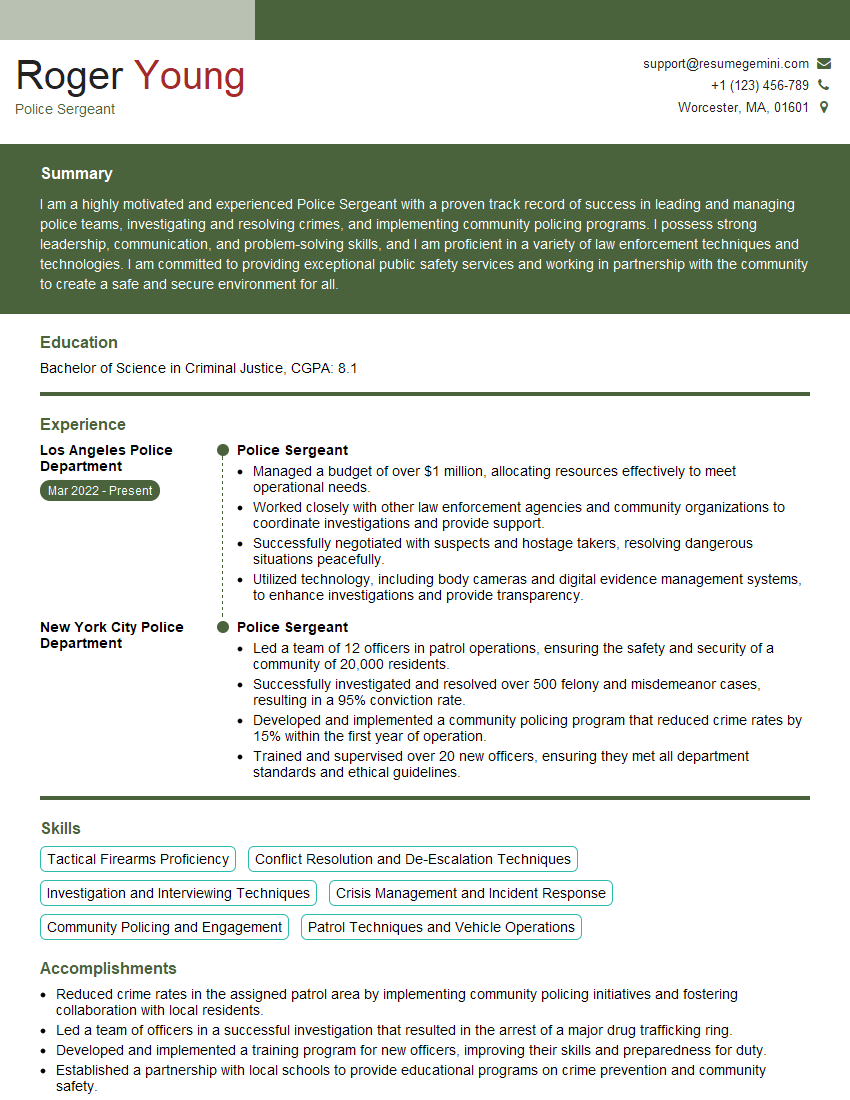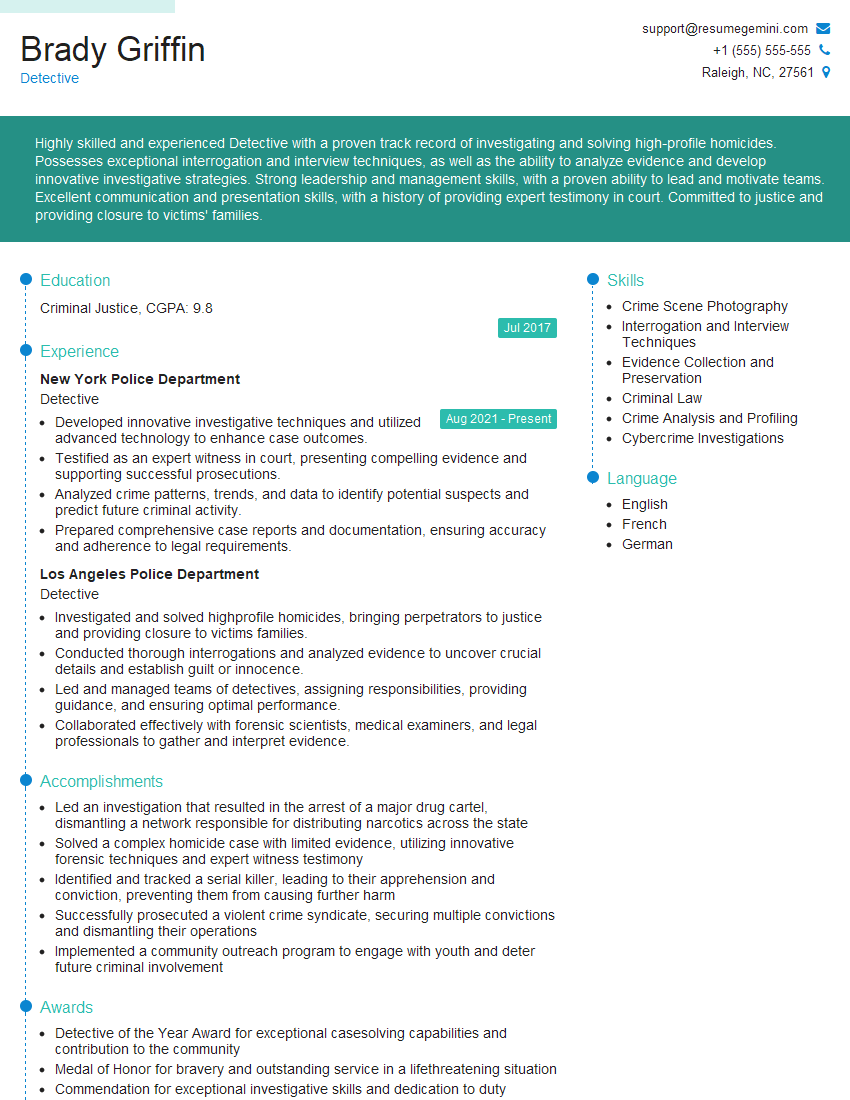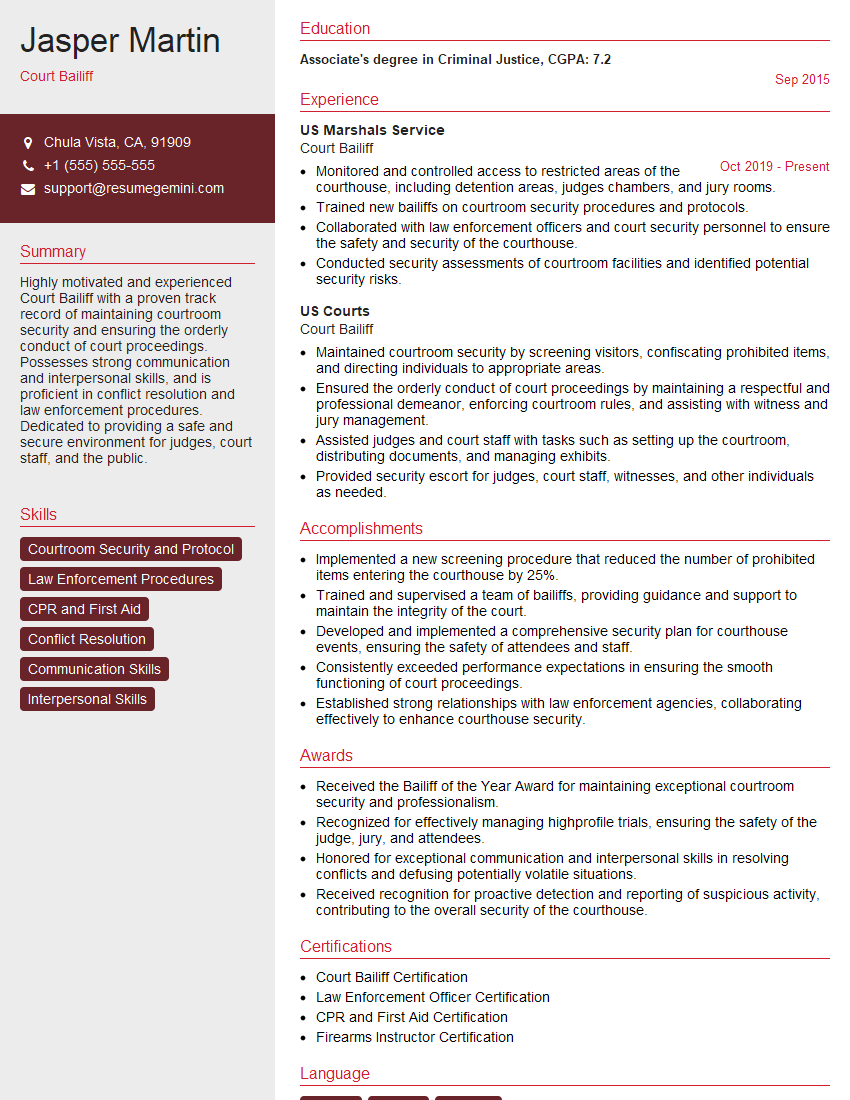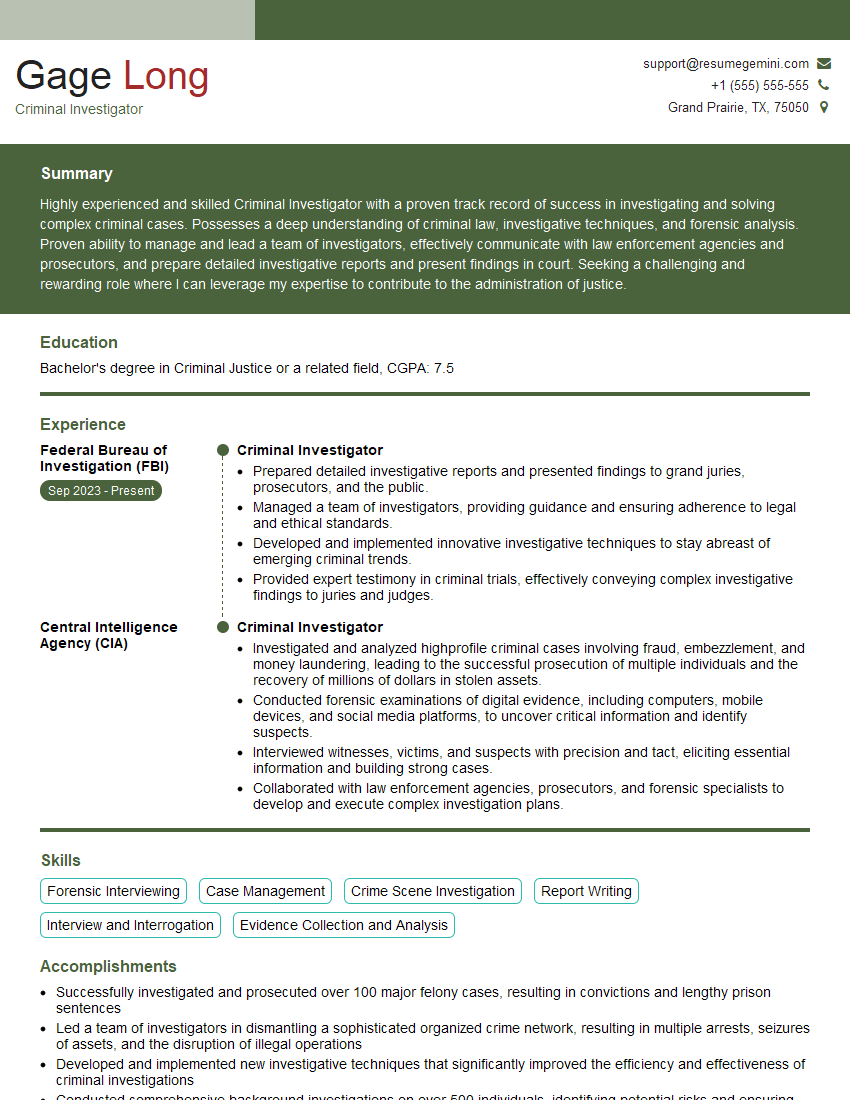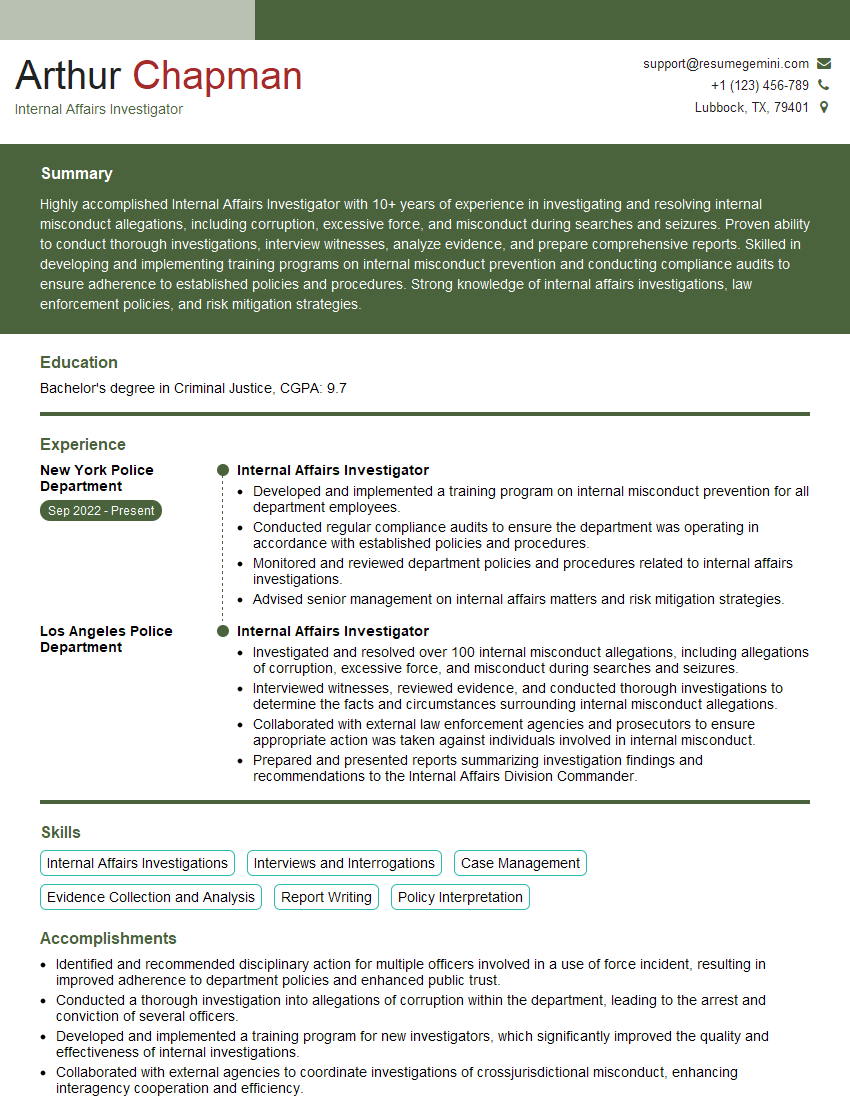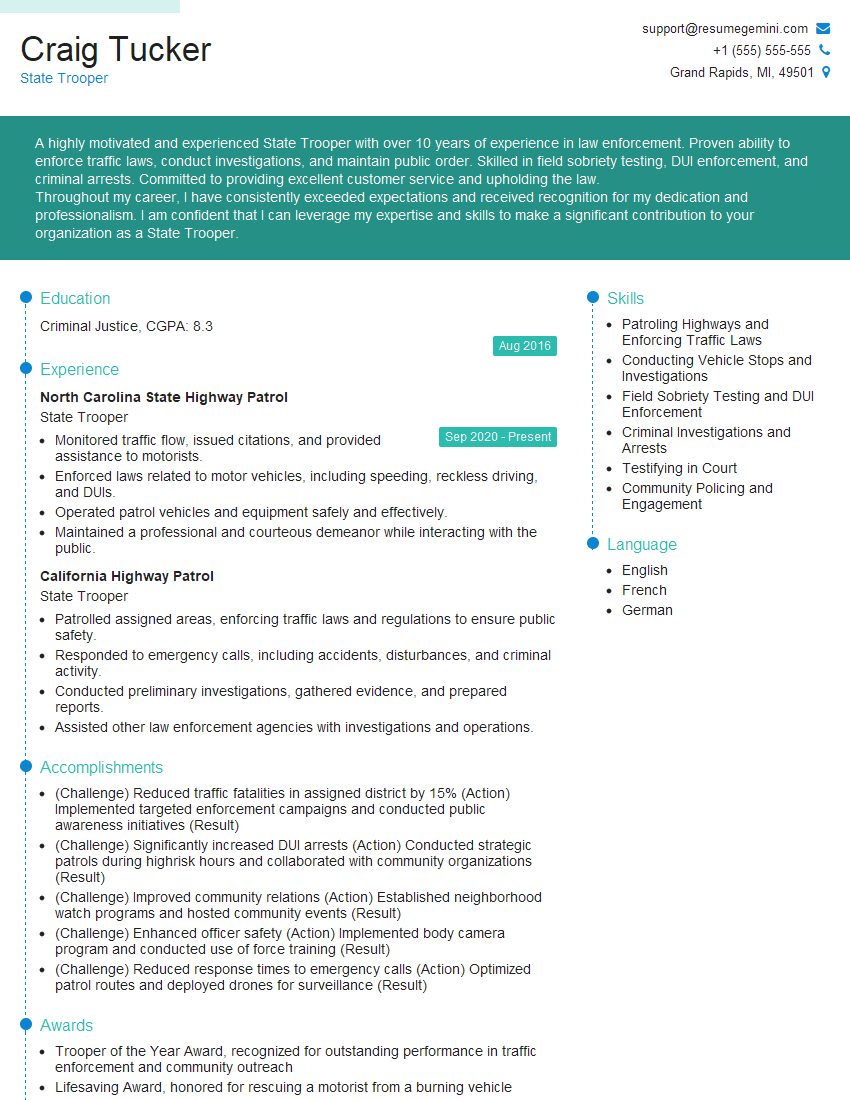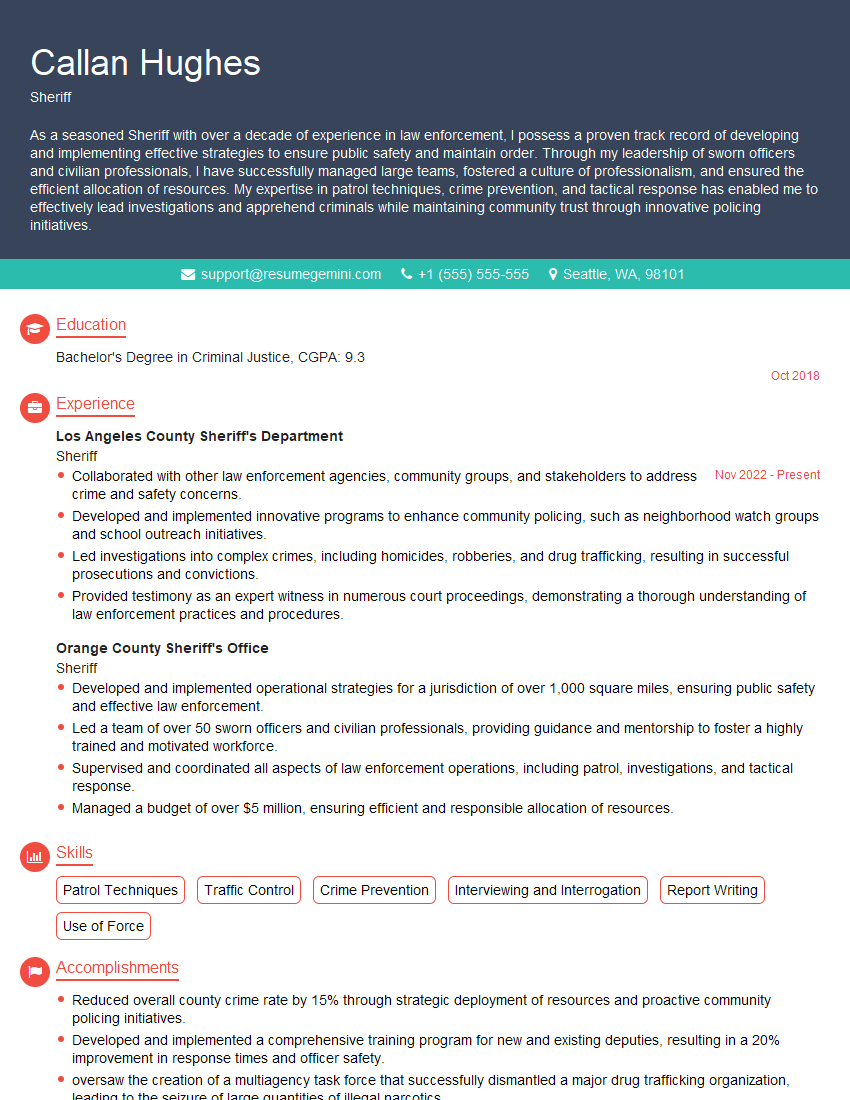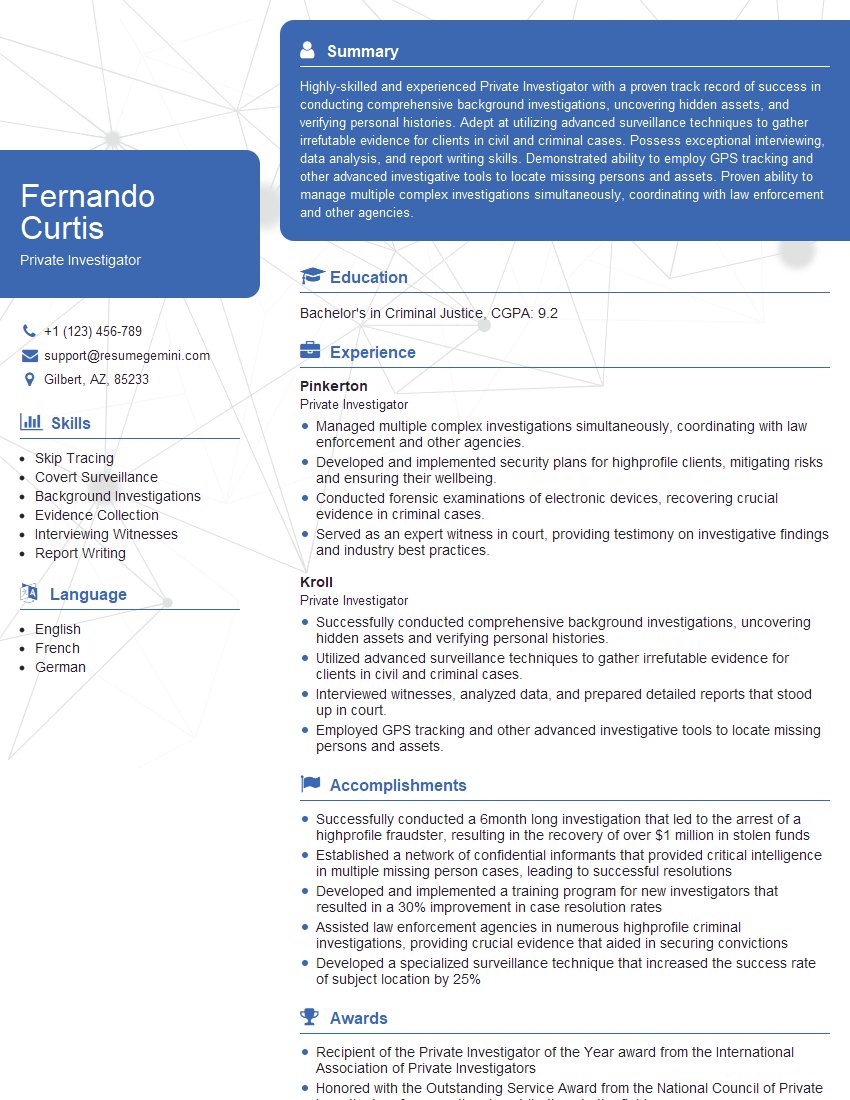Feeling uncertain about what to expect in your upcoming interview? We’ve got you covered! This blog highlights the most important Experience in Law Enforcement or Investigation interview questions and provides actionable advice to help you stand out as the ideal candidate. Let’s pave the way for your success.
Questions Asked in Experience in Law Enforcement or Investigation Interview
Q 1. Describe your experience in conducting thorough background investigations.
Conducting thorough background investigations involves a systematic approach to verifying information about an individual. This goes beyond simply checking records; it’s about piecing together a comprehensive picture of their past, present, and potential future actions. My experience includes utilizing various databases, interviewing numerous references (personal and professional), and conducting physical surveillance when legally permissible and ethically sound. I’ve worked on cases ranging from pre-employment screenings to security clearances, and even assisting in criminal investigations. For instance, in one pre-employment screening, I uncovered inconsistencies between a candidate’s resume and their actual work history, ultimately preventing a potentially disastrous hire. Another case involved verifying the claims of a witness, requiring me to meticulously trace their movements and interactions over several weeks to corroborate their testimony.
- Database Searches: I’m proficient in using state and national databases to check for criminal records, civil judgments, bankruptcies, and other relevant information.
- Interview Techniques: I employ structured interviews, focusing on open-ended questions to elicit detailed and unbiased information. I’m trained to detect deception and navigate difficult conversations.
- Record Review: This includes examining educational transcripts, employment records, financial documents, and any other relevant paperwork to verify claims and identify potential red flags.
Q 2. Explain your understanding of the chain of custody in evidence handling.
The chain of custody is crucial for ensuring the admissibility of evidence in court. It’s a meticulous documentation process that tracks the movement and handling of evidence from the moment it’s discovered to the time it’s presented in court. Any break in this chain can compromise the evidence’s integrity and potentially lead to its exclusion from legal proceedings. Think of it like a relay race; each person handling the evidence is a runner, and they must carefully pass the baton (evidence) to the next runner, documenting every handoff. A strong chain of custody requires detailed logging, including who handled the evidence, when, where, and what actions were taken. This includes signed transfer forms, tamper-evident seals, and secure storage.
For example, imagine a crime scene where a knife is found. The first officer to arrive would bag and label it, documenting the location and time of discovery. Then, they would transfer it to a forensics lab, completing a chain of custody form. The lab technician would document their examination and any changes made to the evidence, before it’s returned to evidence storage, and finally presented in court.
Q 3. How would you handle a situation involving conflicting witness testimonies?
Conflicting witness testimonies are common in investigations. My approach involves carefully analyzing each statement, looking for discrepancies and commonalities. It’s not about finding the ‘right’ witness, but rather building a complete picture. I would first re-interview each witness individually, using open-ended questions to understand their perspective and identify any potential biases. Then, I’d compare their statements meticulously, searching for points of agreement and areas of conflict. This might involve creating a timeline of events or mapping out the scene to see if physical evidence supports or contradicts any account. It’s also important to consider factors like stress, memory limitations, and potential motives for misrepresenting information. For instance, in a case of a robbery, one witness might focus on the weapon while another might remember the getaway car. By combining all accounts and validating them against physical evidence, I can often reconstruct a more accurate sequence of events.
Sometimes, the conflicts are due to misinterpretations or differing vantage points; sometimes, there is deliberate misrepresentation. It’s crucial to remain objective and explore all possibilities. I might also seek additional corroborating evidence to help resolve the contradictions.
Q 4. Describe your experience with surveillance techniques and their legal limitations.
Surveillance techniques are valuable investigative tools, but they must be used responsibly and within strict legal boundaries. My experience encompasses various methods, including visual surveillance (both overt and covert), electronic surveillance (with proper warrants and legal authorizations), and the utilization of technological resources, such as GPS tracking (again, with legal justifications).
It’s absolutely critical to understand the legal requirements and ethical considerations. For example, in many jurisdictions, wiretapping requires a warrant, and even visual surveillance can be restricted in certain areas or situations, to ensure the privacy rights of individuals are protected. I always prioritize adhering to the law; any violation could not only compromise the investigation but also lead to legal repercussions. I’ve used surveillance to track suspects, gather evidence, and verify alibis. A typical example might be using visual surveillance to track a suspect’s movements before conducting an arrest.
Q 5. Explain your proficiency in report writing and case documentation.
Proficiency in report writing and case documentation is essential for effective investigations. My reports are clear, concise, and factual, written in a manner that is easily understandable to both law enforcement professionals and those without a law enforcement background. I meticulously document all aspects of an investigation, including initial observations, witness statements, evidence collected, and the investigative steps taken. This includes clear descriptions of any physical evidence, its location, and chain of custody documentation. I adhere to specific reporting structures and utilize appropriate terminology. I also ensure that all information presented is accurate and unbiased. I’m proficient in using case management software to manage large amounts of data effectively. My goal is to provide a comprehensive and easily accessible record of the investigation.
For example, a report might detail the sequence of events in a burglary, including the time of the incident, evidence found at the scene, witness accounts, and any subsequent actions taken, such as suspect apprehension or the processing of forensic evidence.
Q 6. How do you prioritize tasks and manage time effectively in a high-pressure environment?
Prioritization and time management are paramount in law enforcement, where multiple cases and urgent situations can arise simultaneously. I employ several strategies to manage my workload effectively. These include:
- Prioritization Matrices: I use matrices to categorize tasks based on urgency and importance, allowing me to focus on the most critical tasks first.
- Time Blocking: I allocate specific time slots for particular tasks, helping me stay on track and avoid distractions.
- Delegation: Where appropriate, I delegate tasks to other team members to improve overall efficiency.
- Regular Planning: I engage in daily and weekly planning sessions to review my progress and adjust my schedule as needed.
This system allows me to stay organized even under significant pressure, ensuring that all tasks receive appropriate attention while maintaining a focus on the most critical objectives. Think of it like triage in a hospital; you deal with the most critical cases first while still managing other patients’ needs.
Q 7. Describe your experience with interviewing suspects and witnesses.
Interviewing suspects and witnesses is a crucial aspect of investigation, requiring a combination of skill, empathy, and legal knowledge. My approach involves careful preparation, establishing rapport, employing effective questioning techniques, and documenting everything meticulously. With suspects, I utilize a conversational approach, ensuring their rights are respected, while maintaining a professional demeanor. With witnesses, the goal is to create a comfortable and trusting environment to elicit accurate and detailed information. I avoid leading questions, instead using open-ended questions to encourage them to recount events in their own words. I’m trained in detecting deception and adapting my approach accordingly. I also consider their emotional state and adjust my interview technique to meet their needs while ensuring the integrity of their statement.
For example, in a case involving a theft, I would interview the victim to understand the circumstances of the crime and gather details about the stolen property, then interview potential witnesses to gather information about possible suspects or events that occurred around the time of the crime. Finally, I’d interview the suspect while fully complying with their Miranda rights.
Q 8. How do you maintain objectivity and ethical conduct in challenging situations?
Maintaining objectivity and ethical conduct in law enforcement is paramount. It’s like being a referee in a high-stakes game – you need to call things as you see them, fairly and impartially, even when under pressure. This requires constant self-reflection and a commitment to the highest standards of professional behavior.
I achieve this through several key strategies: First, I meticulously document everything. Detailed notes, accurate recordings, and thorough reports ensure my actions are transparent and verifiable. Second, I actively seek diverse perspectives. I value input from colleagues, supervisors, and even the individuals I’m investigating to minimize bias and gain a holistic understanding. Third, I regularly review ethical guidelines and relevant case law. Staying updated on best practices and legal precedents is essential for ensuring my actions are both lawful and morally sound. Finally, I prioritize my own well-being. Stress and burnout can significantly impair judgment. By maintaining a healthy work-life balance and seeking support when needed, I ensure I remain capable of making objective decisions.
For example, during a high-pressure domestic disturbance call, I consciously prioritized de-escalation techniques over immediate arrest, even though my initial impression might have favored a different approach. Careful observation, active listening, and a focus on the facts allowed me to resolve the situation peacefully and safely.
Q 9. Explain your knowledge of different types of investigative techniques (e.g., undercover operations, forensic analysis).
Investigative techniques are diverse and depend heavily on the specific case. Think of it as a toolbox filled with different tools, each suited for a particular job.
- Undercover Operations: These involve embedding an officer within a criminal network to gather intelligence and evidence. Success requires exceptional acting skills, meticulous planning, and a deep understanding of human psychology. I’ve participated in several such operations, ranging from infiltrating drug rings to investigating white-collar crime. The key is building trust and rapport while maintaining operational security.
- Forensic Analysis: This encompasses a wide range of scientific techniques to examine physical evidence. This might include DNA analysis, fingerprint identification, digital forensics (examining computers and phones), or trace evidence examination. My experience involves collaborating closely with forensic specialists to interpret evidence and build strong cases. For instance, in a burglary case, linking a suspect to the scene through fingerprint analysis was crucial.
- Surveillance: This involves discreetly monitoring individuals or locations to gather intelligence. It may involve physical surveillance (following a suspect), electronic surveillance (wiretaps, etc.), or a combination of both. Ethical considerations and legal constraints are paramount in surveillance operations.
- Interviews and Interrogations: These are crucial for gathering information from witnesses and suspects. Effective interviewing techniques involve active listening, open-ended questions, and the ability to build rapport. Interrogations, however, require a more controlled environment and often involve specific techniques to obtain confessions (always respecting legal rights).
Q 10. Describe your experience with using investigative databases and software.
My experience with investigative databases and software is extensive. I’m proficient in using systems like NCIC (National Crime Information Center), state-level databases, and various specialized software applications for case management and evidence tracking. These tools are crucial for efficiently managing information, identifying patterns, and linking seemingly disparate pieces of evidence.
For example, I once used NCIC to identify a suspect involved in a series of bank robberies across multiple states. The system’s ability to link seemingly unrelated incidents through shared characteristics (modus operandi, physical descriptions, etc.) was instrumental in the apprehension of the suspect. Additionally, I’m familiar with various forensic software packages used to analyze digital evidence, such as recovering deleted files from hard drives or reconstructing timelines from phone records.
Q 11. How would you handle a situation involving use of force?
Use of force is a serious matter governed by strict legal and ethical standards. My training emphasizes de-escalation and the use of only necessary force, employing the principle of proportionality. The goal is always to protect life and maintain safety, both for the officers and the public.
My approach involves a clear escalation of force: verbal commands, followed by less-lethal options (pepper spray, taser), and only as a last resort, lethal force. Every use of force is rigorously documented, reviewed by supervisors, and subject to internal investigations to ensure compliance with department policies and the law. I’ve been involved in several situations requiring the use of force, but in each instance, my actions were carefully considered and aligned with my training and legal obligations. For example, I successfully de-escalated a tense standoff with a suicidal individual using communication and negotiation tactics, avoiding any use of force altogether.
Q 12. Explain your understanding of search and seizure laws.
Search and seizure laws are fundamental to upholding individual rights while allowing law enforcement to conduct effective investigations. These laws, primarily rooted in the Fourth Amendment of the US Constitution, require probable cause for warrants and strict adherence to due process. Probable cause means there’s a reasonable belief, based on facts and circumstances, that a crime has been committed and evidence of that crime will be found in a specific location.
Understanding the nuances of search warrants, consent searches, and exceptions to the warrant requirement (like exigent circumstances or plain view) is crucial. Illegal searches can lead to evidence being suppressed, compromising investigations. I am very familiar with these nuances and consistently ensure that all searches are conducted lawfully. I would never proceed with a search without a valid warrant, unless an exception to the warrant requirement applies.
Q 13. How would you handle a situation involving a potentially dangerous suspect?
Encountering a potentially dangerous suspect requires a cautious and strategic approach. Prioritizing safety is paramount, both for myself and the public. I would assess the situation, considering the suspect’s behavior, the environment, and any available information. I would attempt to establish communication, emphasizing de-escalation tactics and clear instructions. If direct confrontation is necessary, I would utilize cover and concealment, ensuring I have backup support and employing appropriate tactical maneuvers.
For instance, if faced with a suspect wielding a weapon, I would prioritize establishing a safe perimeter and calling for backup before making any attempts to approach. The goal is to neutralize the threat while minimizing the risk of harm to all involved. My training encompasses various tactical techniques and use-of-force scenarios to handle such situations effectively and safely.
Q 14. Describe your experience working as part of a team.
Teamwork is the cornerstone of effective law enforcement. My experience working in diverse teams has taught me the importance of collaboration, communication, and mutual respect. I’ve participated in investigations requiring coordinated efforts across multiple units, agencies, and even jurisdictions. Effective teamwork involves clearly defining roles, responsibilities, and objectives, establishing open communication channels, and leveraging individual expertise to achieve common goals.
In one particular case, we were able to successfully solve a complex narcotics trafficking ring through collaborative efforts between our department’s detective unit, the DEA, and local informants. Successful coordination, information sharing, and respectful collaboration between all parties involved were essential to the success of the operation.
Q 15. How do you adapt to changing priorities and unexpected situations?
Adapting to shifting priorities and unexpected events is crucial in law enforcement. It’s like navigating a constantly changing landscape; you need flexibility and a proactive approach. My strategy involves several key elements:
- Prioritization: I use a system to rank tasks based on urgency and importance, constantly reassessing as new information emerges. For example, if a high-priority witness becomes available unexpectedly, I’ll immediately adjust my schedule to secure their testimony, even if it means postponing less critical tasks.
- Resourcefulness: I’m adept at identifying and utilizing available resources effectively. This includes leveraging technology, collaborating with colleagues, and seeking guidance from supervisors when needed. During a large-scale emergency, for instance, I might coordinate with other agencies to share information and resources, optimizing our response.
- Problem-Solving: I employ a systematic approach to problem-solving, breaking down complex situations into manageable steps. This allows me to address immediate issues while keeping the long-term goals in mind. Think of it as putting out small fires while still working towards extinguishing the main blaze.
- Mental Agility: Maintaining a calm and focused demeanor under pressure is paramount. I’ve learned to adapt my communication and approach to different personalities and situations, ensuring I remain effective even in high-stress environments. Deep breaths and strategic thinking are key.
Essentially, it’s about remaining adaptable, resourceful, and mentally agile. This ensures I can effectively respond to the demands of any given situation while maintaining focus on achieving the overall investigative objectives.
Career Expert Tips:
- Ace those interviews! Prepare effectively by reviewing the Top 50 Most Common Interview Questions on ResumeGemini.
- Navigate your job search with confidence! Explore a wide range of Career Tips on ResumeGemini. Learn about common challenges and recommendations to overcome them.
- Craft the perfect resume! Master the Art of Resume Writing with ResumeGemini’s guide. Showcase your unique qualifications and achievements effectively.
- Don’t miss out on holiday savings! Build your dream resume with ResumeGemini’s ATS optimized templates.
Q 16. Describe your experience in analyzing evidence and drawing conclusions.
Analyzing evidence and drawing conclusions is a meticulous process requiring both analytical skills and a deep understanding of investigative principles. I approach this in a structured manner:
- Collection and Documentation: Firstly, thorough and meticulous documentation of all evidence is essential, maintaining a detailed chain of custody. This ensures admissibility in court and prevents any potential challenges to the integrity of the investigation. I use digital tools for this, including databases and specialized software.
- Analysis and Interpretation: This phase involves a systematic review of the collected evidence – physical objects, witness statements, digital data, etc. I look for patterns, inconsistencies, and connections to form a comprehensive picture. For instance, comparing DNA evidence with witness accounts can help create a stronger case.
- Correlation and Inference: I correlate different pieces of evidence, looking for connections and drawing inferences based on logical reasoning and established investigative techniques. This often involves brainstorming with colleagues to generate different perspectives.
- Conclusion Formulation: Finally, based on the analyzed evidence and my professional experience, I formulate well-supported conclusions, which are always clearly documented and presented. This includes acknowledging uncertainties and limitations, maintaining intellectual honesty.
A classic example is piecing together a crime scene: analyzing blood spatter patterns, forensic evidence from the victim, and witness statements to reconstruct the sequence of events and identify the perpetrator.
Q 17. How do you maintain confidentiality and protect sensitive information?
Maintaining confidentiality and protecting sensitive information is paramount in law enforcement. It’s a fundamental principle that underpins public trust. I adhere to strict protocols to ensure this:
- Access Control: I only access information relevant to my investigation and strictly adhere to authorization levels. Accessing data without proper authorization is a serious breach of policy.
- Secure Storage: All sensitive information, both physical and digital, is stored in secure locations using encryption and access control measures. This includes passwords, encryption keys and physical locking systems.
- Data Handling: I follow strict guidelines for handling sensitive information, including shredding physical documents and securely deleting digital files. This includes employing anti-virus software and firewall protocols.
- Communication: I exercise caution when discussing sensitive information, only doing so with authorized personnel and using secure communication channels. I never discuss confidential matters in public or in unsecured locations.
- Reporting: I report any potential breaches or compromises of sensitive information immediately to my supervisor. I understand this responsibility and take it incredibly seriously.
For example, witness statements containing personal information are kept in secured files, and access is limited only to authorized individuals. Digital evidence is often encrypted and stored on secure servers.
Q 18. Explain your knowledge of relevant laws and regulations (e.g., Miranda Rights).
A thorough understanding of relevant laws and regulations is fundamental to my work. This knowledge ensures that all investigative actions are legal, ethical, and admissible in court. The Miranda Rights, for example, are a cornerstone of due process:
Miranda Rights: These rights inform individuals of their constitutional protections when they are taken into custody. Specifically, they have the right to remain silent, the right to an attorney, and the right to have an attorney appointed if they can’t afford one (Miranda v. Arizona, 384 U.S. 436 (1966)).
Beyond Miranda, my knowledge encompasses:
- Search and Seizure Laws: Understanding the Fourth Amendment’s protections against unreasonable searches and seizures and the requirements for obtaining warrants based on probable cause is crucial.
- Evidence Law: Knowledge of rules of evidence, including admissibility standards, is essential for building a strong and legally sound case.
- Criminal Procedure: Familiarity with the stages of the criminal justice process, from arrest and interrogation to trial and sentencing, is critical for effective investigation.
- Specific State and Federal Laws: My understanding extends to relevant state and federal laws pertaining to specific crimes under investigation, ensuring I operate within the legal framework.
Failing to understand and adhere to these laws could lead to the dismissal of charges, compromising the integrity of investigations. Therefore, continuous professional development on legal updates is integral to my role.
Q 19. Describe your experience with crisis management and de-escalation techniques.
Crisis management and de-escalation techniques are vital skills, especially in high-pressure situations involving potentially violent or emotionally charged individuals. My approach focuses on:
- Assessment: The first step is to quickly assess the situation, identifying the triggers and potential risks involved. This includes identifying the emotional state of those involved and assessing the immediate environment.
- Communication: Effective communication is crucial, including maintaining a calm, respectful, and empathetic tone while clearly articulating expectations. Active listening helps to understand the individual’s perspective.
- De-escalation Techniques: I utilize various de-escalation tactics, such as maintaining a safe distance, avoiding confrontational body language, and using verbal techniques to calm the situation. Creating space and providing a sense of control to the person in distress can often help.
- Collaboration: In many situations, collaboration with mental health professionals or specialized crisis teams is necessary. This is often especially helpful with individuals facing mental health crises.
- Safety Procedures: Throughout the process, I prioritize the safety of myself, other officers, and the individuals involved. This often involves having backup available and ensuring a safe environment.
For instance, in a domestic dispute, I might use active listening to understand both parties’ perspectives before attempting to mediate the conflict and ensure the safety of those involved. If de-escalation fails, then appropriate force may be necessary, always within legal boundaries.
Q 20. How do you identify and mitigate risks in an investigation?
Identifying and mitigating risks in an investigation is an ongoing process requiring proactive planning and careful assessment. My approach involves:
- Risk Assessment: I begin by identifying potential risks, both physical and operational, through a comprehensive assessment. This considers aspects like the nature of the crime, the individuals involved, and the environment.
- Mitigation Strategies: For each identified risk, I develop mitigation strategies. This might involve surveillance, undercover operations, protective measures for witnesses, or the use of specialized equipment.
- Contingency Planning: I create contingency plans for unexpected events or setbacks. This involves having alternative approaches ready in case the initial plan fails.
- Communication and Collaboration: Open communication and collaboration with colleagues, supervisors, and other agencies are essential for sharing information and coordinating risk mitigation efforts.
- Review and Adjustment: Throughout the investigation, I regularly review the risk assessment and adjust mitigation strategies based on new information or changing circumstances.
For example, if investigating a high-risk gang-related crime, I would consider the potential for violence, develop strategies for protecting informants, and coordinate with other law enforcement agencies for enhanced surveillance and backup.
Q 21. Explain your experience with undercover work or similar covert operations.
Undercover work requires a unique skill set, including exceptional acting ability, strong observational skills, and the capacity to build trust while maintaining a professional detachment. My experience includes:
- Role Development: Developing a believable persona that fits the specific undercover operation, understanding the environment and target’s habits and behaviours is a key aspect of undercover work. This requires in-depth research and meticulous planning.
- Information Gathering: Collecting intelligence by establishing relationships, gaining trust, and observing the target’s activities. I’ve used techniques ranging from casual conversations to building relationships in order to gather vital information.
- Relationship Building: Building rapport and trust with the targets and other individuals in the operational environment is essential for long term missions.
- Risk Management: Undercover work inherently carries significant risks, including exposure, danger to personal safety, and psychological toll. I’ve taken great care in planning these operations to minimize risks to my safety and that of the team.
- Debriefing and Documentation: Thorough debriefing and meticulous documentation of all activities and observations are critical for ensuring the success of the undercover mission and for later analysis and reporting.
For example, in an operation targeting drug trafficking, I might adopt a false identity as a potential buyer to build rapport, gather intelligence, and eventually assist in making an arrest. These operations require careful planning, constant assessment of risk, and absolute commitment to operational security.
Q 22. How do you handle stressful situations and maintain composure under pressure?
Stress management in law enforcement is paramount. It’s not about eliminating stress, which is impossible in our field, but about developing coping mechanisms to manage it effectively. My approach is multifaceted. Firstly, I prioritize physical and mental well-being. This includes regular exercise, a healthy diet, and sufficient sleep. Secondly, I utilize mindfulness techniques, like deep breathing exercises, to center myself during high-pressure situations. Thirdly, and critically, I rely on a strong support network of colleagues and family, creating a safe space to debrief and process challenging experiences. For example, during a hostage situation, my focus shifts to tactical procedures while simultaneously employing deep breathing to regulate my heart rate and maintain clarity of thought. Post-incident, debriefing with colleagues helps process the emotional impact and learn from the experience.
Q 23. Describe your experience with community policing and building relationships with the public.
Community policing is more than just patrolling; it’s about building trust and fostering positive relationships with the community we serve. During my time in the precinct, I actively participated in community events, such as neighborhood watch meetings and youth outreach programs. I believe in proactive engagement. This means initiating conversations, listening to concerns, and addressing issues before they escalate. For instance, I regularly visited local businesses, getting to know owners and staff, which allowed me to identify potential problems early on. This approach proved instrumental in preventing several burglaries by building a rapport with business owners who then became valuable sources of information. Building these relationships also increased community trust and resulted in higher reporting rates of crimes.
Q 24. How do you evaluate the credibility of witnesses and informants?
Evaluating witness and informant credibility is crucial. It’s a process of triangulation, where information from multiple sources is compared and verified. I assess the witness’s demeanor, observing for signs of deception, such as inconsistencies in their story or evasiveness. I examine their past record and potential biases. For informants, I carefully evaluate their motivation – are they seeking leniency, revenge, or financial gain? Corroborating their information with independent evidence is crucial. For example, an informant might claim a drug stash is hidden in a specific location. We wouldn’t rely solely on their word; we’d seek independent verification, such as surveillance or a search warrant. The reliability of the source is directly proportional to the strength of the corroborating evidence.
Q 25. Explain your proficiency in using various technological tools in an investigation.
Proficiency in technology is essential in modern investigations. I am skilled in using various software and hardware tools, including:
- Forensic software: For analyzing digital evidence, such as recovering deleted files from computers or extracting data from mobile phones. I’m proficient in using tools like EnCase and FTK.
- Surveillance technology: I have experience deploying and monitoring CCTV cameras, body-worn cameras, and GPS tracking devices.
- Database management: I’m adept at using various databases to store and analyze crime data, linking patterns and identifying trends.
- Mapping software: Tools like ArcGIS allow for the visualization of crime hotspots, aiding in resource allocation and strategic planning.
For example, in a recent case, we used facial recognition software to identify a suspect from a security camera image, leading to his arrest.
Q 26. Describe your experience presenting evidence and findings in court or to other stakeholders.
Presenting evidence effectively requires clear communication and strong organizational skills. I prepare meticulously, ensuring all evidence is presented logically and persuasively. This includes creating clear and concise reports, organizing physical evidence, and rehearsing my testimony. I always tailor my presentation to the audience—whether it’s a jury, a judge, or another law enforcement agency. For example, when presenting to a jury, I focus on using plain language and avoiding technical jargon. I might use visual aids, like photographs or diagrams, to illustrate key points and maintain audience engagement. A strong understanding of the legal process is essential, ensuring evidence is admissible and presented in a way that supports the narrative.
Q 27. How do you stay current with changes in law enforcement techniques and technology?
Staying current in law enforcement is an ongoing process. I actively participate in professional development courses, attend conferences, and read industry publications to keep abreast of the latest techniques and technologies. I also leverage online resources and participate in professional networks to share best practices and knowledge with peers. For example, I recently completed a course on advanced cybercrime investigation techniques, learning about new tools and methodologies for investigating online fraud and other digital crimes. Continuous learning is essential to adapting to the evolving nature of crime and technology.
Q 28. Explain your understanding of criminal profiling and psychological analysis.
Criminal profiling and psychological analysis are valuable tools in investigations. Profiling involves developing a behavioral profile of an offender based on crime scene analysis, victim characteristics, and other evidence. This helps narrow down the suspect pool and develop investigative strategies. Psychological analysis goes beyond profiling and involves understanding the offender’s motivations, mindset, and potential future actions. It’s important to note that profiling is not an exact science but a valuable investigative aid. For example, in a series of burglaries, analyzing the target selection and method of entry might reveal patterns indicating a specific type of offender, informing the focus of the investigation. Combining profiling with other investigative techniques significantly increases the chances of identifying and apprehending the perpetrator.
Key Topics to Learn for Experience in Law Enforcement or Investigation Interview
- Investigative Techniques: Understanding various investigative methodologies, from initial response and evidence collection to interviewing techniques and report writing. Practical application includes describing your experience in applying these methods in specific scenarios.
- Legal Frameworks and Procedures: A strong grasp of relevant laws, regulations, and legal procedures crucial for conducting investigations ethically and legally. Practical application involves detailing how you’ve ensured compliance with these frameworks in your past roles.
- Crime Scene Management: Understanding the importance of securing and processing crime scenes, preserving evidence, and maintaining chain of custody. Practical application might include describing your experience in managing a complex crime scene and the challenges overcome.
- Communication and Interpersonal Skills: Effective communication is paramount. This includes interacting with victims, witnesses, suspects, and colleagues. Practical application involves showcasing your ability to build rapport, de-escalate tense situations, and clearly articulate complex information.
- Problem-Solving and Critical Thinking: Law enforcement and investigation require analytical skills to analyze information, identify patterns, and draw logical conclusions. Practical application focuses on describing how you’ve used these skills to solve challenging cases.
- Technology in Investigations: Familiarity with various technologies used in modern investigations, including databases, forensic tools, and surveillance equipment. Practical application includes highlighting your proficiency with specific technologies and their effective use in your investigations.
- Ethical Considerations: Understanding and adhering to the highest ethical standards in all aspects of law enforcement and investigation. Practical application includes demonstrating your commitment to integrity and accountability.
Next Steps
Mastering these key areas significantly enhances your career prospects in law enforcement and investigation, opening doors to advanced roles and increased responsibilities. A well-crafted, ATS-friendly resume is crucial for showcasing your skills and experience effectively to potential employers. ResumeGemini is a trusted resource that can help you build a professional and impactful resume tailored to your unique experiences. We provide examples of resumes specifically designed for candidates with experience in law enforcement and investigation to help you create a compelling application.
Explore more articles
Users Rating of Our Blogs
Share Your Experience
We value your feedback! Please rate our content and share your thoughts (optional).
What Readers Say About Our Blog
Hi, I’m Jay, we have a few potential clients that are interested in your services, thought you might be a good fit. I’d love to talk about the details, when do you have time to talk?
Best,
Jay
Founder | CEO



